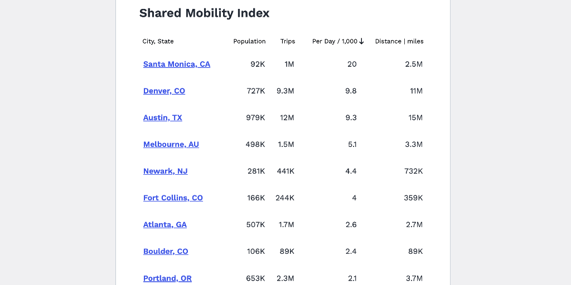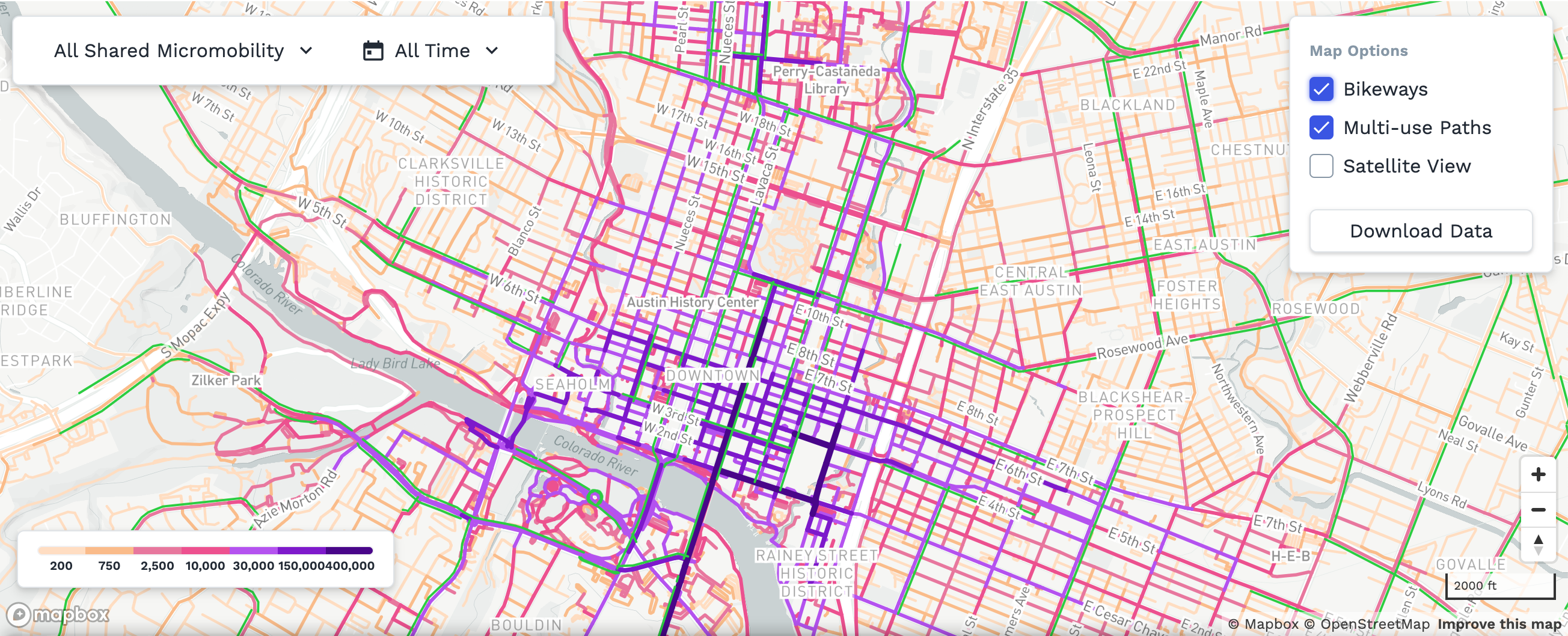Behold, a Ride Report dream comes true!
For the last four years, we’ve worked with city, state, regional, and federal agencies around the world to ingest data from millions of shared bike and scooter trips. This granular data, when safely aggregated and visualized, shows how, when, and where people bike and scooter.
With the Shared Mobility Index, you get access to these powerful insights in your city. And can compare across our partner cities. All in one place! The Index represents stats for 16 programs – with more cities on the way. Just today we added Greensboro and Durham, North Carolina.
Click here to explore the Shared Mobility Index.
Why is this the Shared Mobility Index a Ride Report dream come true?
In order to meet our climate goals and shift our cities away from automobiles, we desperately need more and better data to meet the sophistication, standards, and power of automobile data.
Shared mobility data helps bolster the case for this change, especially when made accessible to advocates, researchers, and planners. So we’ve worked closely with our city and operator partners to host this information, in a form that's visually compelling, centralized, and that safeguards personal information.
Some background on how we got here
If you’ve followed along on the dockless saga, you know it’s been a wild ride. We’ve come a long way as an industry. Remember back in 2018, when scooters started falling from the sky? The backlash? Op-eds? Tarring and feathering town hall meetings? Vandal accounts? The poop?
At the time, our four-person team quickly assembled the first software tool (literally using duct tape at one point) to help cities navigate the storm. We made a dashboard that ingests vehicle data and enabled simple rule-making, reporting, and predictability for city staff. It brought visibility and guidance to a phenomenon that was largely out of view from staff managing city streets.
Since then, we’ve heard countless stories of how Ride Report’s dashboard empowered program staff to show up at community meetings, internal meetings, or in “gotcha” interviews and be able to confidently say, “check out these stats. Companies are following the rules. We’re learning so much from our pilot.” And, clearly demonstrate that shared micromobility is here to stay, that it provides a meaningful mobility option that didn’t exist before.
Ride Report’s core product facilitates the data exchange between the companies who operate the vehicles, the people who ride the vehicles, and the agency staff who regulate the vehicles. We’re proud to demonstrate the importance of a trusted third party in this process, and the role of data in – not just stabilizing shared micromobility – but ensuring its growth. Because the future of shared micromobility is more than just rule compliance and vehicle management.
As an industry, our growth relies on modeshift. The success of shared bikes and scooters relies on an exponentially growing number of people who are willing to try something new and develop an everyday habit with unfamiliar rules, etiquette, routines, and know-how.
It’s well known, cities with highest ridership have quickly invested in, what’s commonly referred to as, the virtuous cycle. Advocates and leaders work together to expand infrastructure (e.g., protected bike lanes, parking corrals, etc.), programming (e.g., Sunday car-free days, universal bike education, etc.), and new rider initiatives (e.g., bikeshare, ebike rebate programs, etc.). These investments attract new riders, who then create more demand for more improvements, which then attracts even more riders. Modeshift relies on this feedback loop.
We’re eager to support modeshift, specifically:
- More. Protected. Bike. Lanes.
Build networks of safe, ubiquitous, connected maintained places to ride. Seville invested in a 112 mile network and ridership increased 452%. People ride scooters on sidewalks, simply because they don’t have a better alternative. In Portland, survey respondents ranked bike lanes as their preferred road type, and sidewalks last (P. 6). Ride Report tools help identify priority corridors where people already are “voting with their wheels” and provide trip estimates to justify the demand for improvements. - Increased fleet caps.
Shared bikes and scooters reduce the barriers of purchasing, storing, and maintaining a bike. They facilitate flexible, spontaneous transportation decisions. But in order to be useful, vehicles need to be there when you need them. Studies show a vehicle must reliably be within a 3-5 minute walking distance (P. 6). We help cities identify their fleet cap expansion policies, and ensure they’re coupled with thoughtful policies and management tools. - Equitable access.
To acknowledge, repair, and prevent racism, ableism, ageism, and classism in transportation, shared micromobility should follow Principles of Mobility Justice. And while there are no one-size-fits-all solutions, we agree programs must seek to be more price, language, digitally, ability, and geographically accessible. Ride Report’s tools support geographic access. We’ve worked with the majority of our partners to identify and monitor rebalancing minimums for designated opportunity areas – the priority neighborhoods that might not otherwise see steady rebalancing.
How data brings sophistication and storytelling to modeshift
We’re proudly working alongside a coalition transforming micromobility. Our partners at the Shared Use Mobility Center are releasing the 2030 Action Agenda this fall. This industry-wide strategic plan will identify, measure, and set timelines for major advancements in shared micromobility, like infrastructure and policy change. And data will play a critical role in this process because we can't move the needle if there is no needle.
Up until this point, city planners and advocates have relied on manual bike counts and static counters to understand ridership patterns. Fleets of GPS-enabled vehicles mean that, for the first time ever, we have a treasure trove of information on how, when, and where people move about cities. Most importantly, this granular data, uses a similar set of standards and privacy protections with cities around the world, which brings us closer to the sophistication of automobile and level-of-service data collection.
Since our early days, we’ve sought a meaningful way to share these insights beyond our agency and operator partners. Sharing out fleet metrics requires a great deal of buy-in and trust building in addition to being thoughtful about aggregation and granularity of data. These partners have comprehensive data-sharing agreements and critical trade secrets to protect. Understandably, building partner support required time.
Launching Open Data Portals
After a few years of working together we’ve come to a shared agreement as an industry, that when we bring the insights of shared micromobility to the public, the industry as a whole benefits. These insights help ask the right questions, identify priorities, defend priorities, and tell stories of change.
With this understanding, Ride Report launched Open Data Portals as a way for a broader audience to access this rich new data source.
The Shared Mobility Index is a quick summary view of our current Open Data Portals. We chose a few key metrics for this first version, and have lots of ideas in the works to continue adding layers of context for better comparisons.
Though we want to know – what other metrics should appear on this page? How can this be more useful for your campaign, project, or paper? Click here to let us know how you're using the index, share your suggestions, and receive updates on new cities, new features, and quarterly data refreshes.


